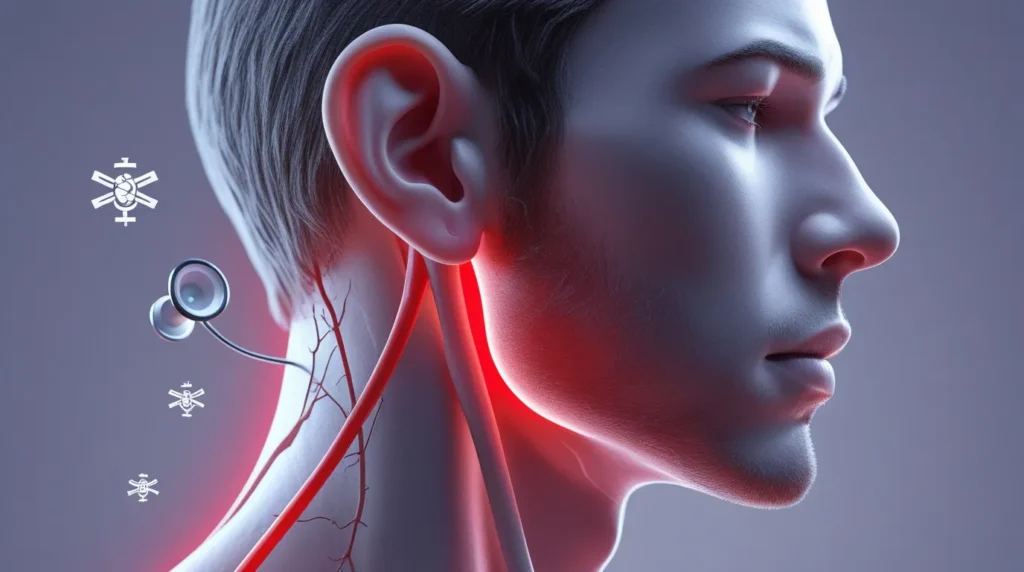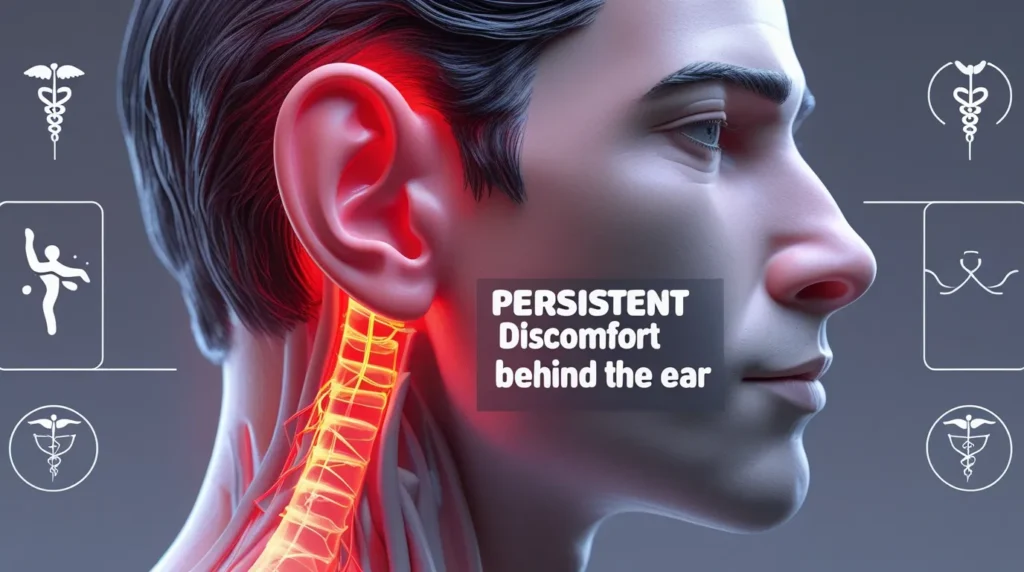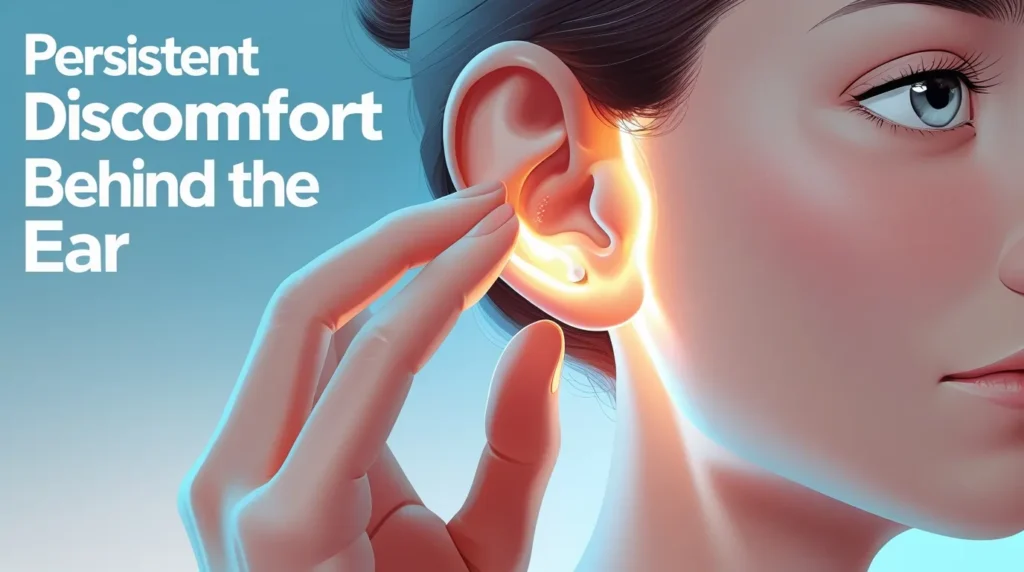Persistent discomfort behind the ear is more than a minor annoyance. Many people experience a dull ache, sharp pain, or pressure that simply won’t go away. Unlike ordinary earaches, persistent discomfort behind the ear can last for days, weeks, or even months, affecting your daily life.
It can be linked to ear infections, nerve pain, or issues with the jaw and neck. Understanding the causes, symptoms, and treatments can help you manage this discomfort effectively and prevent long-term complications.
What Does Persistent Discomfort Behind the Ear Mean?

When you experience persistent discomfort behind the ear, it usually signals more than temporary irritation. This type of discomfort can include mild soreness, pressure, or sharp pain. Often, the pain radiates toward the jaw, neck, or scalp. Unlike regular earaches that fade in a few days, this persistent pain can indicate chronic earache caused by underlying medical conditions. Some individuals report tingling sensations, swelling, or a feeling of fullness in the ear. This signals that nerves around the ear may be involved, or that inflammation is present.
Many people confuse ordinary headaches with ear discomfort, but the difference lies in the location and persistence. Headaches usually affect the forehead or temples, while persistent discomfort behind the ear tends to stay localized, often intensifying with jaw movement or pressure on the neck. Early recognition is key to proper treatment, preventing the pain from worsening or spreading.
Common Causes of Discomfort Behind the Ear

Several factors contribute to persistent discomfort behind the ear. The most common causes include ear infections, TMJ disorder, sinus infections, and neck stiffness. Ear infections can inflame the inner or outer ear, causing sharp pain and pressure. TMJ disorder, which affects the jaw joint, often leads to pain behind the ear that worsens with chewing or speaking.
Sinus infections also trigger pressure behind the ear due to congestion and inflammation. Additionally, poor posture or prolonged tension can cause neck stiffness, which radiates pain to the ear area. Migraine headaches sometimes mimic ear pain, creating a confusing picture. In rare cases, nerve irritation or inner ear issues can produce chronic pain that persists without clear external signs.
Medical Conditions Linked with Persistent Pain
Medical conditions play a significant role in why discomfort persists. Ear infections are among the most common, but swollen lymph nodes or mastoiditis (infection of the skull bone behind the ear) can also be responsible. TMJ disorder often leads to jaw and ear pain, while chronic sinusitis can cause pressure that lasts for weeks.
In some situations, nerve pain in the cranial or cervical nerves may result in persistent discomfort. Inner ear issues like Meniere’s disease or labyrinthitis can cause vertigo alongside ear pain. It’s crucial to differentiate between temporary irritation and conditions that need medical treatment. Ignoring these can lead to hearing problems or long-term nerve complications.
Symptoms That Should Not Be Ignored

If persistent discomfort behind the ear comes with additional warning signs, prompt medical evaluation is essential. Watch for:
- Hearing problems or muffled hearing
- Swelling behind the ear or around the jaw
- Fever or drainage from the ear
- Dizziness or loss of balance
- Sharp headaches or neck pain
These symptoms may indicate chronic earache, infections, or nerve involvement. Early diagnosis helps prevent long-term complications, and a doctor may recommend tests such as CT scans, hearing exams, or blood work to pinpoint the cause.
When to Seek Professional Medical Help
Not all ear discomforts are dangerous, but knowing when to see a doctor is critical. If your pain lasts more than a week or comes with behind the ear swelling, seek help. Persistent nerve pain or jaw discomfort also warrants a specialist visit.
Doctors can determine whether TMJ disorder, ear infections, or other conditions are causing the pain. Timely intervention can prevent permanent damage to hearing, nerves, or jaw function. If left untreated, conditions like mastoiditis or chronic sinus infections may escalate, requiring more aggressive treatment.
Home Remedies for Mild Ear Discomfort

For mild cases of persistent discomfort behind the ear, home remedies can offer relief. Warm compresses applied to the affected area help reduce inflammation and ease tension. Gentle massage around the jaw can alleviate TMJ-related pain, while neck stretches reduce neck stiffness.
Other tips include staying hydrated, getting enough sleep, and managing stress, which can trigger migraine headaches affecting the ear. Avoiding loud noises and keeping the ear dry can prevent infections from worsening. While these remedies don’t replace professional care, they can provide comfort and support healing.
Medical Treatments for Chronic Ear Pain
If discomfort continues despite home remedies, medical treatments are necessary. Antibiotics treat bacterial ear infections, while anti-inflammatory medications reduce pain and swelling. For TMJ disorder, dentists may recommend splints or physical therapy to ease jaw tension.
Chronic sinus infections may require decongestants or surgery in severe cases. In rare instances, surgical procedures may address inner ear issues or behind the ear swelling. Doctors often combine treatments with lifestyle advice, ensuring that the pain is managed both medically and preventively.
Differences Between Discomfort Behind the Ear and Other Ear Pains
It’s important to distinguish persistent discomfort behind the ear from common earaches. Ordinary ear pain usually fades within a few days and is often linked to minor infections. In contrast, persistent pain signals ongoing issues like nerve pain, chronic earache, or TMJ disorder.
Symptoms such as dizziness, jaw stiffness, or headaches help differentiate the causes. Recognizing these differences allows doctors to provide targeted treatments, preventing complications and improving recovery.
Preventive Tips for Avoiding Discomfort Behind the Ear

Prevention is often the most effective approach. Regular exercise helps maintain proper posture, reducing neck stiffness that can radiate pain to the ear. Managing allergies prevents sinus infections, a common source of pressure behind the ear.
Using ear protection in loud environments can prevent hearing problems. Regular dental checkups help identify TMJ disorders early. Simple lifestyle adjustments, such as reducing stress and stretching the neck, can minimize the risk of developing persistent discomfort behind the ear.
Long-Term Health Risks if Left Untreated
Ignoring persistent discomfort behind the ear can have serious consequences. Untreated ear infections may damage hearing, while chronic nerve pain can spread to the jaw and neck. Conditions like TMJ disorder or untreated sinus infections may worsen over time.
Persistent pain also impacts mental health, causing sleep disturbances, anxiety, and decreased quality of life. Early diagnosis and treatment prevent these complications, improving overall health and daily function.
Final Thoughts on Managing Persistent Discomfort
Living with persistent discomfort behind the ear can be frustrating, but proper care makes relief possible. From lifestyle adjustments to medical treatments, many options are available. Always pay attention to warning signs like ear canal pressure or behind the ear swelling, and consult a doctor if pain persists. Acting early ensures better health outcomes and restores comfort in daily life.
Quick Comparison Table: Causes, Symptoms, Treatments
| Cause | Symptoms | Treatments |
|---|---|---|
| Ear Infection | Sharp pain, fever, drainage | Antibiotics, pain relievers |
| TMJ Disorder | Jaw pain, ear ache, clicking | Splints, therapy, exercises |
| Sinus Infection | Pressure, congestion | Decongestants, antibiotics |
| Nerve Pain | Tingling, chronic ache | Medications, nerve therapy |
| Neck Stiffness | Pain radiating to ear | Stretching, massage, posture correction |
Full Body Health Checkup at Home Your Complete Guide to Wellness
FAQs
1. Why do I have a weird feeling behind my ear?
A weird feeling behind your ear can be caused by ear infections, nerve irritation, or muscle tension. Sometimes, it may also result from TMJ disorder or swollen lymph nodes.
2. Why do I have a dull ache behind my ear?
A dull ache behind the ear is often due to ear infections, mastoiditis, or tension in the neck muscles. It can also be linked to TMJ problems or sinus pressure.
3. What causes mastoiditis in children?
Mastoiditis in children is usually caused by untreated middle ear infections, which spread to the mastoid bone behind the ear.
4. What is the dull ache in the bone behind the ear?
This dull ache is often due to mastoid bone inflammation, infection, or pressure from nearby ear infections or swelling.
5. Are there lymph nodes behind your ears?
Yes, small lymph nodes are located behind the ears. They may swell due to infections or immune responses.
6. What is neuralgia behind the ear?
Neuralgia behind the ear is nerve pain in the area, often caused by irritation or compression of cranial nerves, leading to sharp or burning sensations.
7. What is the three finger test for mastoiditis?
The three finger test checks for tenderness, swelling, or pain behind the ear using three fingers to press around the mastoid bone.
8. Why do I have a pain in my neck behind my ear?
Pain in the neck behind the ear can result from muscle strain, nerve irritation, lymph node swelling, or referred pain from ear infections.
9. How to detect mastoiditis?
Mastoiditis is detected through physical examination, checking for swelling, redness, tenderness behind the ear, and sometimes CT scans or blood tests.
10. What can be mistaken for mastoiditis?
Conditions like ear infections, TMJ disorders, lymph node swelling, or skin infections can mimic mastoiditis symptoms.
11. Can a CT scan detect mastoiditis?
Yes, a CT scan is the most reliable imaging tool to detect mastoid bone infection and inflammation.
12. What is the common age for mastoiditis?
Mastoiditis most commonly affects children under 2–3 years old, though it can occur at any age following ear infections.





Pingback: Pain Behind Ear And Neck Causes, Symptoms, And Relief
Pingback: Tips For Mental Peace: Simple Daily Habits For A Calmer Mind